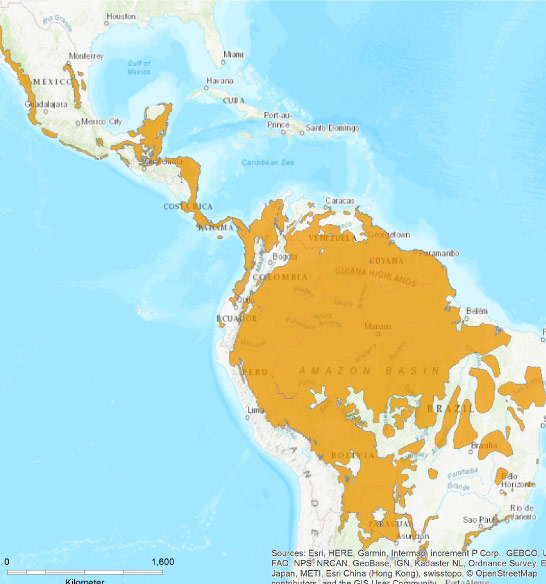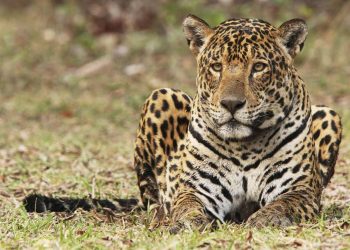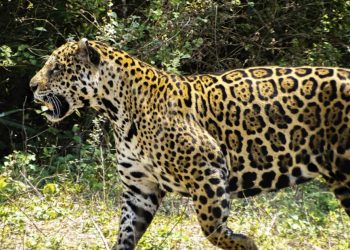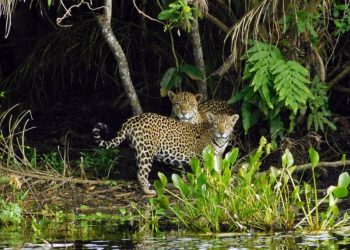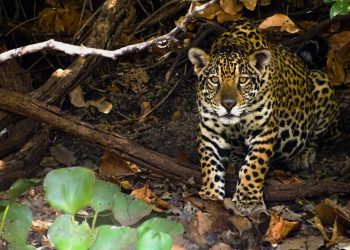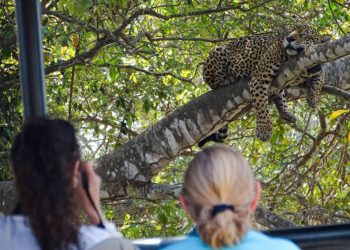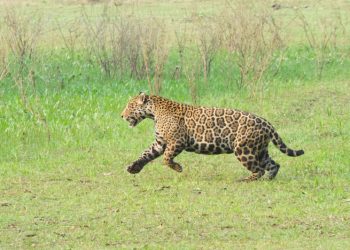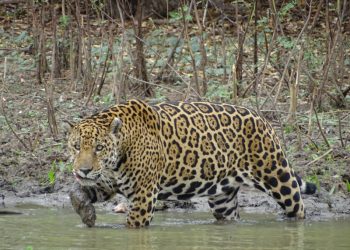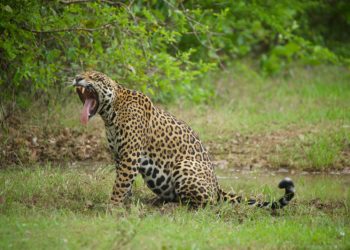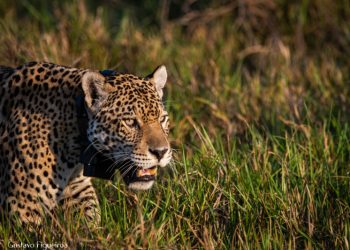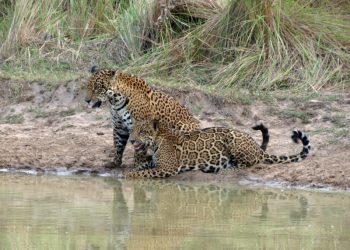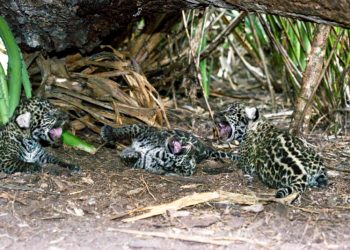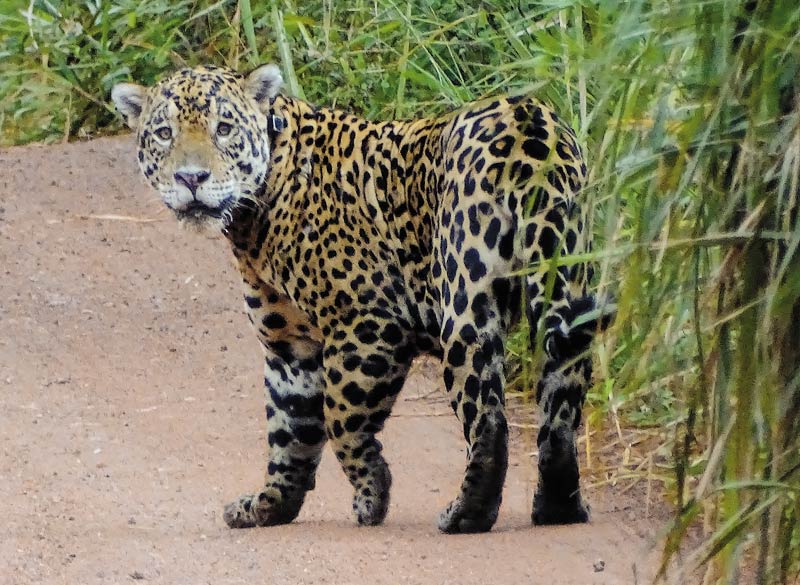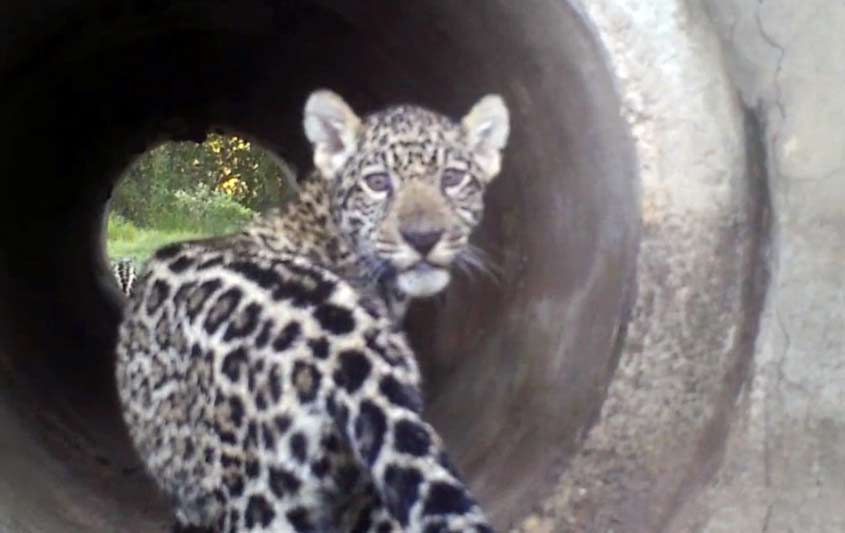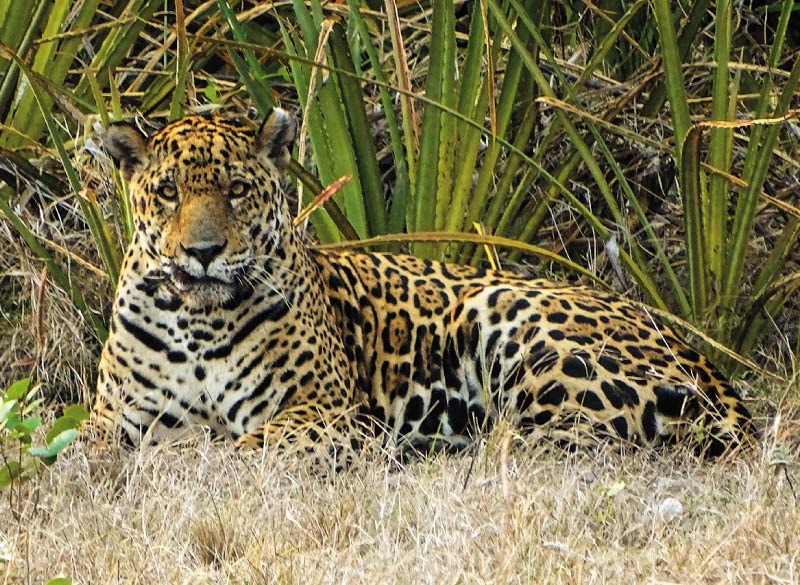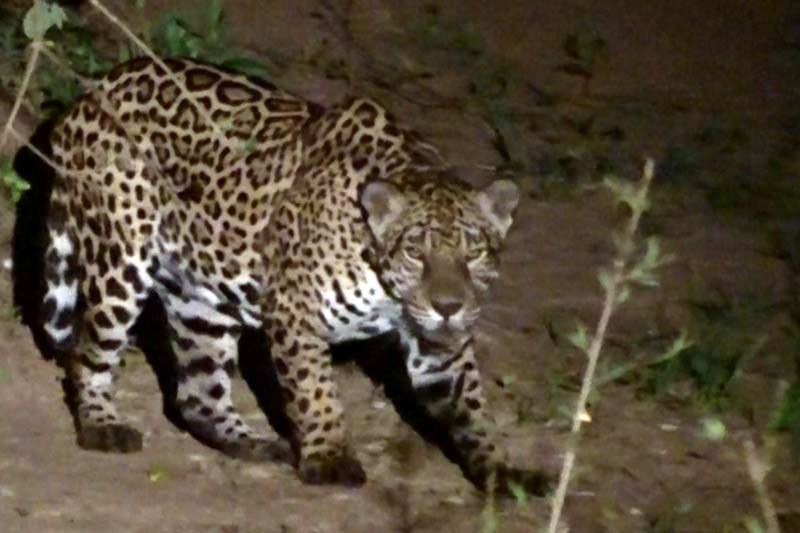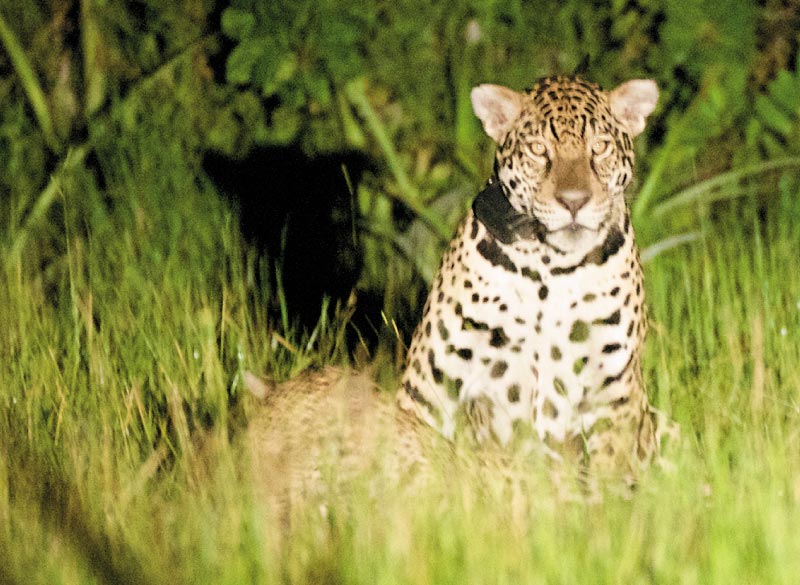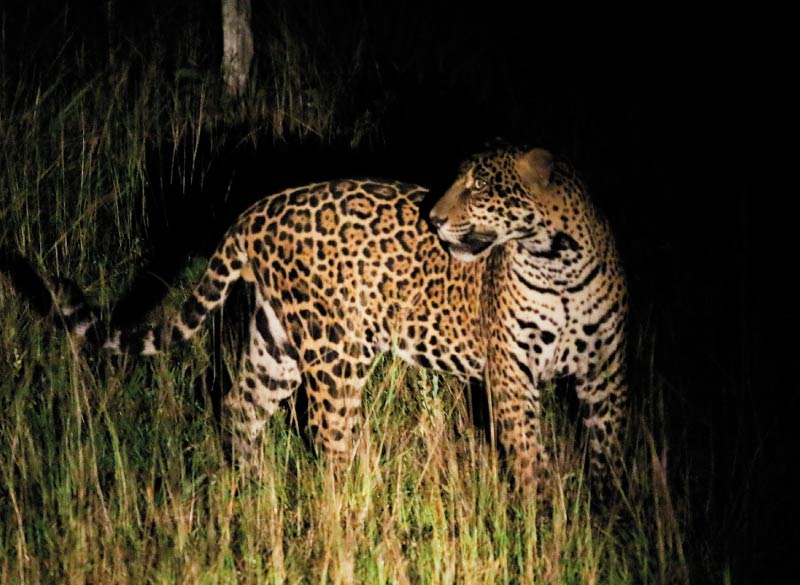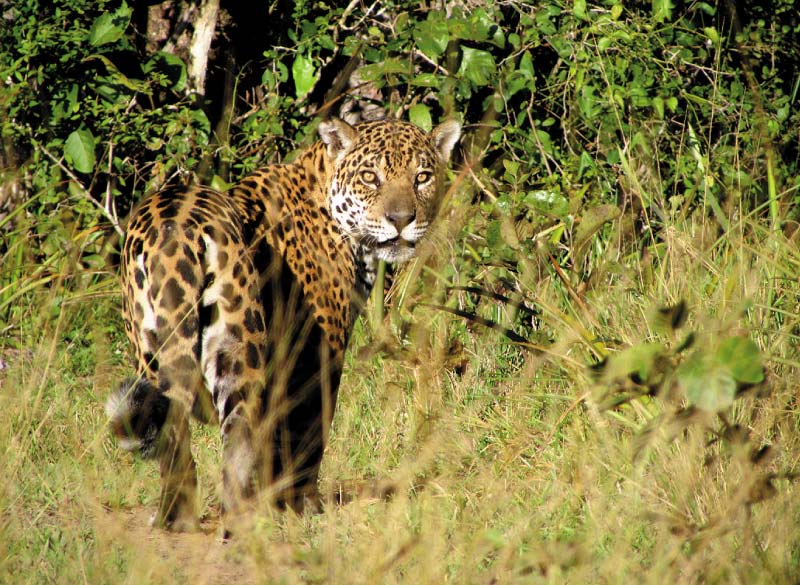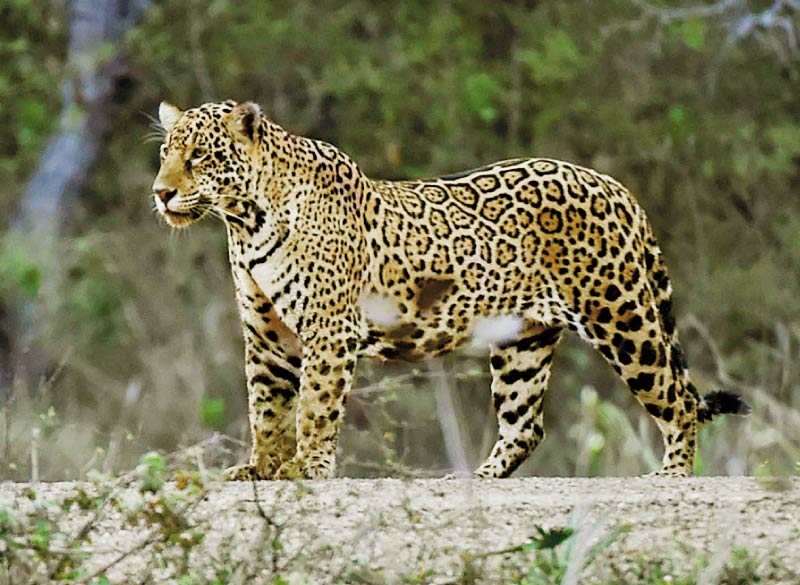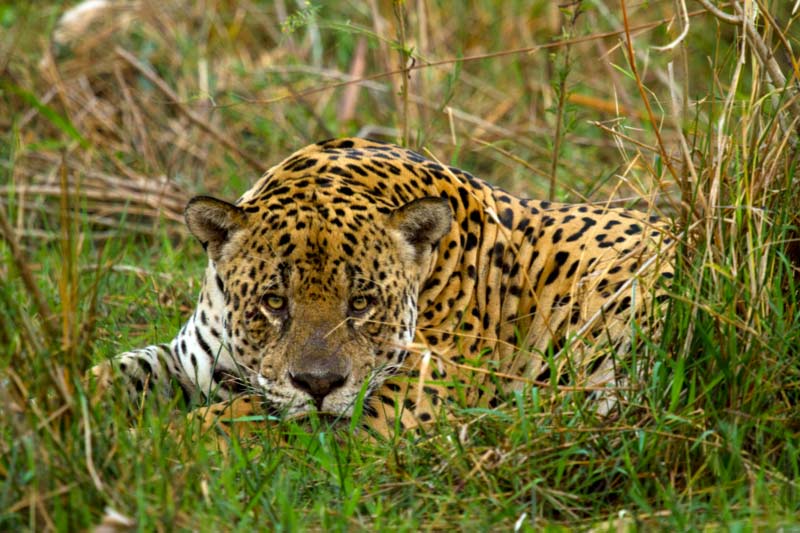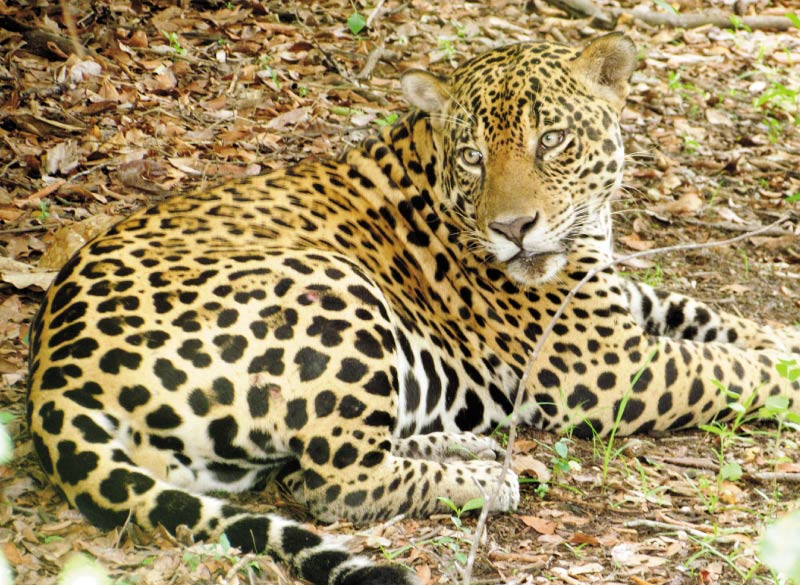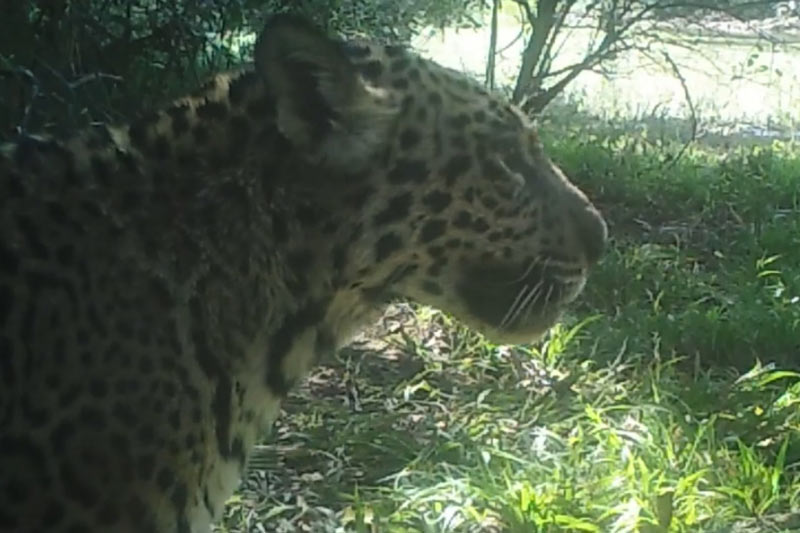Considered one of the top predators of the animal kingdom, the jaguar reigns in the environments where it lives, feeding on small armadillos and agoutis, to alligators and tapirs.
Click to learn more
The jaguar (Panthera onca) is the largest cat in the Americas, and the third largest cat in the world, after the tiger (Panthera tigris) and the lion (Panthera leo). It is known by several names in the different regions where it is found: black jaguar, jaguar, jaguaretê, yaguareté, tigre, canguçu, pintada, pinima, pinima-malha-larga and pixuna.
Considered one of the top predators of the animal kingdom, the jaguar reigns in the environments where it lives, feeding on small armadillos and agoutis, to alligators and tapirs. Jaguars control populations of prey and are extremely important in the balance of the ecosystems in which they are integrated. They are strict carnivores – they feed exclusively on meat. Taking their size into account, jaguars have the most powerful bite among the felines, even stronger than that of the tiger and the lion.
The jaguar has predominantly crepuscular and nocturnal habits, more active at dusk and dawn, although it is not unusual to find them moving and hunting during the day. Their living area varies greatly, depending on the environment, the availability of prey and the population density of jaguars.
Distribution
The jaguar was originally found from the southwestern United States to the central region of Argentina. Today, it is present from Mexico to the north of Argentina. It also appears in almost all of Brazil, which has the largest population of jaguars in the world, as Brazil is the leading country of long-term conservation and survival of the species.
Jaguars adapt to different types of ecosystems. They may inhabit areas of closed forest, open fields or arid and semi-desert regions, although they prefer wetlands with bodies of water. In Brazil, they are found in almost all biomes except in the Pampa, where they are already extinct.
In the Pantanal and the Amazon, the jaguar populations are larger and more stable due to the lower rate of human occupation and large preserved areas. In the Cerrado the population is smaller, but still exists in considerable numbers. In the Caatinga and the Atlantic Rainforest the numbers are very small, and there is serious risk of local extinction.
The living areas of jaguars vary greatly from the north to the south of the country due to certain factors such as prey availability, water sources, population density of other jaguars and biome characteristics.
Habitat sizes may differ between neighboring animals, so it is not always possible to determine the overall average dimensions of jaguar living spaces. These expanses vary between 30 square kilometers in the Pantanal, to 1,300 square kilometers in the Cerrado. The smallest habitat areas are in the Pantanal, probably because of the high availability of food. The largest are situated in the Cerrado and the Atlantic Forest, possibly due to greater difficulty in finding food and other resources, such as reproductive partners.
Males occupy territories on average three times larger than those of females. Having cubs is a contributing factor: females with small cubs usually inhabit more compact living areas because the mother has to curtail her walks to shorter distances as the cubs cannot keep up with her normal pace.
Features
The jaguar is a big cat of the Felidae family. It belongs to the genus Panthera, the same genus as lions, leopards, tigers and snow leopards.
The coloration is golden-yellow, with spots on the head, paws and neck. The rest of the body displays rosettes of color with spots contained inside these rosettes (one of the characteristics that distinguishes jaguars from leopards), which provides a high degree of camouflage when in the forest. The pattern of dots is unique for each animal: each jaguar has a different mesh of rosettes, working as a kind of “fingerprint”. This helps us to better identify and study each individual.
Jaguars are large, muscular animals; their weight and size varies according to the environment. On average, they weigh between 65 and 100 kilograms, but males weighing over 148 kilograms have previously been registered in the Pantanal. Jaguars from the Pantanal are larger and more robust than jaguars from other biomes, probably due to the greater availability of prey in the biome and less dense vegetation. In biomes such as the Atlantic Forest and the Amazon, the individuals are smaller and slimmer, allowing them to travel more easily through areas of heavy forest.
Body length, from the snout to the tip of the tail, can reach 2.5 meters, while their withers (height from the front paw to the scapula) measure 85 centimeters in height.
As in other cats of the genus Panthera (lion, leopard, tiger and snow leopard), the jaguar’s hyoid bone – located in the throat region – is not completely ossified, allowing this group of animals to emit more significant sounds. The most famous of these is the roar of the lion, which can be heard from more than five kilometers away. In jaguars, this sound is known as stamina.
Melanism
The incidence of black jaguars is relatively frequent. Melanism is caused by a mutation in a specific gene: this genetic alteration results in the addition of melanin – one of the proteins responsible for pigmentation – that causes the animal’s coat to deepen. Melanism is not exclusive to jaguars, and has been recorded in 13 species of cats around the world.
Black jaguars belong to the same species as the common jaguar; the only difference is their darker coat. Under observation in bright light it is possible to distinguish the rosettes – the common pattern on the coats of all jaguars – hidden in their black coats. There are records of black jaguars in the Amazon, the Caatinga, the Cerrado and the Atlantic Forest. In the Pantanal, the occurrence of melanic individuals has not yet been proven. Some researchers believe that the absence of melanism in the biome is caused by factors such as humidity, temperature, precipitation, and especially solar radiation.
Behavior
Jaguars, in general, are animals with crepuscular and nocturnal habits, more active at dusk and dawn. Their peak activity is usually in the late afternoon/early evening, but they often remain active for much of the night, until sunrise. This does not mean they are dormant during the day. Depending on the location and the type of prey they are stalking, they will comfortably hunt during the daylight hours.
For a long time it was believed that jaguars were totally solitary animals, intolerant of the presence of other jaguars in their domain. However, we, at Onçafari, have found females to be more accepting of other females in their territories over the years. We previously registered seven jaguars dividing the same carcass, which, until that occurrence, was considered to be a very unlikely event. It is reasoned that when the food resource is in plentiful supply, tolerance between individuals increases. Therefore it is better to share food than to run the risk of serious injury, or even death, in a fight.
One of the ways in which jaguars communicate is through vocalization. The sturgeon is utilized in different ways and in different tones to communicate with other jaguars, and can be used to call cubs, to scare off competitors or to attract males (in the case of females in heat).
Because they are territorial animals, jaguars mark their areas with feces, urine, floor markings made with their feet, called scrapes, and rubbing of certain body parts, to leave their smell and scratches on trees. (Scratching on trees is also used to sharpen the claws.) In addition to trees, jaguars rub against such objects as shrubs and rocks, distributing important olfactory information: for example, the receptivity of females for mating. Their vocalizations are also a very important form of communication between individuals, each containing a series of distinct signals that governs the complex social interactions of the species.
Food
Jaguars are strictly carnivorous, feeding only on meat. As they are animals at the top of their food chain, more than 80 species contribute to their diet. The jaguar is able to prey on virtually any terrestrial or semi-aquatic animal in its ecosystem. They feed on smaller animals, such as armadillos, fish, quatis and monkeys, although they prefer medium and large animals, such as deer, alligators, capybaras and even tapirs.
In environments that have been altered by man – with less availability of natural targets (peccaries, tapirs, capybaras, alligators) – jaguars may have to hunt farm animals, such as cattle. This generates a conflict with farmers, and the jaguars are often killed as a form of retaliation or to prevent their attacks on domestic animals.
Jaguars employ a different technique from other cats when slaughtering their prey. Unlike other felines that bite the neck, suffocating their victim, jaguars usually bite the animal at the base of the skull at the back of the neck. However, they also bring the target down by biting its snout. In addition, they are able to chase and hunt their quarry on land, water and in trees.
Reproduction
According to the literature, jaguars reach sexual maturity around the age of two years; our team has registered females already mating at approximately 15 months of age. Usually, males only join females during the reproductive season, at which time they may spend a few days together. Our team has recorded the average staying time between couples of lasting from four to five days, a period during which they do not hunt, feeding only when they find a carcass, and sometimes even getting killed by another jaguar. During this period, fights between males occur and the female may change partners. Copulation is fast, lasting only a few seconds, so is repeated several times throughout the day, becoming more intense and frequent at times when temperatures are warmer (between dawn and dusk).
There is no regulated reproductive period; the jaguar mates all year round. Copulation is a little aggressive. Males have spicules in their penis, which facilitates the embedding of the organ in the vaginal canal of the female. However, these spikes can hurt her during the act. During intercourse, the male bites the back of the female’s neck, which helps to stimulate ovulation. The vocalizations during the biting and copulations sound aggressive to the listener, but all these behaviors and stimuli are part of the natural mating repertoire of the species.
The gestation time varies between 93 and 105 days and can generate between one and four cubs. Over the years of field monitoring, our team has recorded a higher frequency of one to two cubs per litter. The mother takes care of the cubs on her own without any help from the male. Cubs remain with their mother until they reach approximately two years of age (although sometimes less so), after which time they start to stray in search of their own territory. This two-year period is essential for the cub, as it learns from the mother during this time how to hunt, defend itself and interact with the environment. Some females settle within their mother’s living area; she will tolerate them far more easily than unrelated females. The males, in general, disperse to new locations, far from where they were born. They hardly ever return to the home area, which reduces the chances of inbreeding.
Conservation
Although the jaguar is already extinct in several of the places where it previously existed, Brazil is home to approximately 50% of the remaining populations of jaguars. The Amazon is currently the largest refuge for jaguars throughout its distribution, followed by the Pantanal. However, in biomes such as the Atlantic Forest and the Caatinga, the species runs a serious risk of extinction.
As a predator at the top of the food chain, the jaguar needs a healthy and balanced environment in order to survive. The species helps to control populations and is a very important element of the ecosystem within which it is integrated, generating a positive impact on the scale of the landscape. However, populations of jaguars have been decreasing over the decades due to different factors, including habitat loss, hunting and, more recently, China’s demand for bones, teeth and other parts of the species used for traditional Chinese medicine.
Jaguars are threatened with extinction and are considered “vulnerable” (VU) according to the Red Book of Endangered Brazilian Fauna (ICMBio, 2018). According to the International Union for Conservation of Nature (IUCN, 2018), they are considered as “almost threatened” (NT).
Although the general status is one of vulnerability, conservation varies by biome:
Amazon: “Almost threatened”
Due to the size of the forest still under protection and the availability of resources, the Amazon continues to house the largest population of jaguars in the world. Notwithstanding, hunting and the rapid pace of deforestation in the biome continue to threaten local populations.
Pantanal: “Almost threatened”
The Pantanal is the biome that has been least altered by man over the years, contributing to a less disturbing situation in this biome than in others. The highest densities of jaguars in the world exist in the Pantanal thanks to the plentiful availability of food. The main threat here is hunting for retaliation for cattle predation.
Atlantic Forest: “Critically endangered”
It is estimated that there are fewer than 300 jaguars in the entire length of the remaining Atlantic Forest. This figure is so low that even if hunting and deforestation were to cease immediately, these populations have already been condemned to extinction within the next 90 years.
Cerrado: “In danger”
Jaguar populations in this biome have diminished by more than 50% in the last 25 years, mainly due to agricultural advancement in indigenous forest areas. These populations are in better condition than those of the Atlantic Forest and Caatinga, but are still at serious risk over time.
Caatinga: “Critically endangered”
As in the Atlantic Forest, the situation of the jaguars of the Caatinga is also very critical. Researchers estimate that there are less than 300 jaguars in the entire biome. Little is known about the jaguars of this particular biome, which adds to the difficulties of conservation.
Pampa: “Extinct”
Reports reveal there was once a high concentration of jaguars in the Pampa. The conversion of the natural habitat, however, in conjunction with extreme hunting, has led to the complete disappearance of the species in the biome. The last known jaguar in the Pampa is believed to have been killed by hunters in 1952. The demise of the jaguars in this biome could be repeated in many other areas where the species is still found. Population trends indicate a severe decline, showing the urgency of immediate action for conservation of the area.
Threats
Habitat fragmentation and the loss of forest areas due to human action are the main threats to jaguars. Deforested areas for agricultural production and expansion of cities reduce the living areas of these predators, also decreasing the availability of natural prey.
The second major threat to these felines is hunting. In the past, jaguars were killed for the removal and sale of their hide as decorative items. In the 1960s, about 15,000 jaguar skins were exported each year. During this period, populations were drastically reduced. Although the marketing of hides is now banned, hunters are still killing jaguars. As farmers alter the environment for raising cattle or other animals and hunt various species of wild prey, the availability of food decreases. This results in increased contact between jaguars and humans and, ultimately, the predation of cattle, generating a long-standing conflict between ranchers and jaguars.
More information
Culture
Jaguars have been part of the culture of the native peoples of the Americas for millennia.
References to the jaguar section:
National Jaguar Conservation Plan:
http://www.icmbio.gov.br/portal/images/stories/docs-plano-de-acao/pan-onca-pintada/livro-onca-pintada.pdf
Book: Panthera onca – in the shadow of the forests, by Adriano Gambarini, Laís Duarte, Mario Haberfeld and Rogério Cunha de Paula
Book: The Jaguar in the Pantanal Culture, by Adriano Gambarini, Lais Duarte and Mario Haberfeld
Image Gallery
photo: Edu Fragoso

